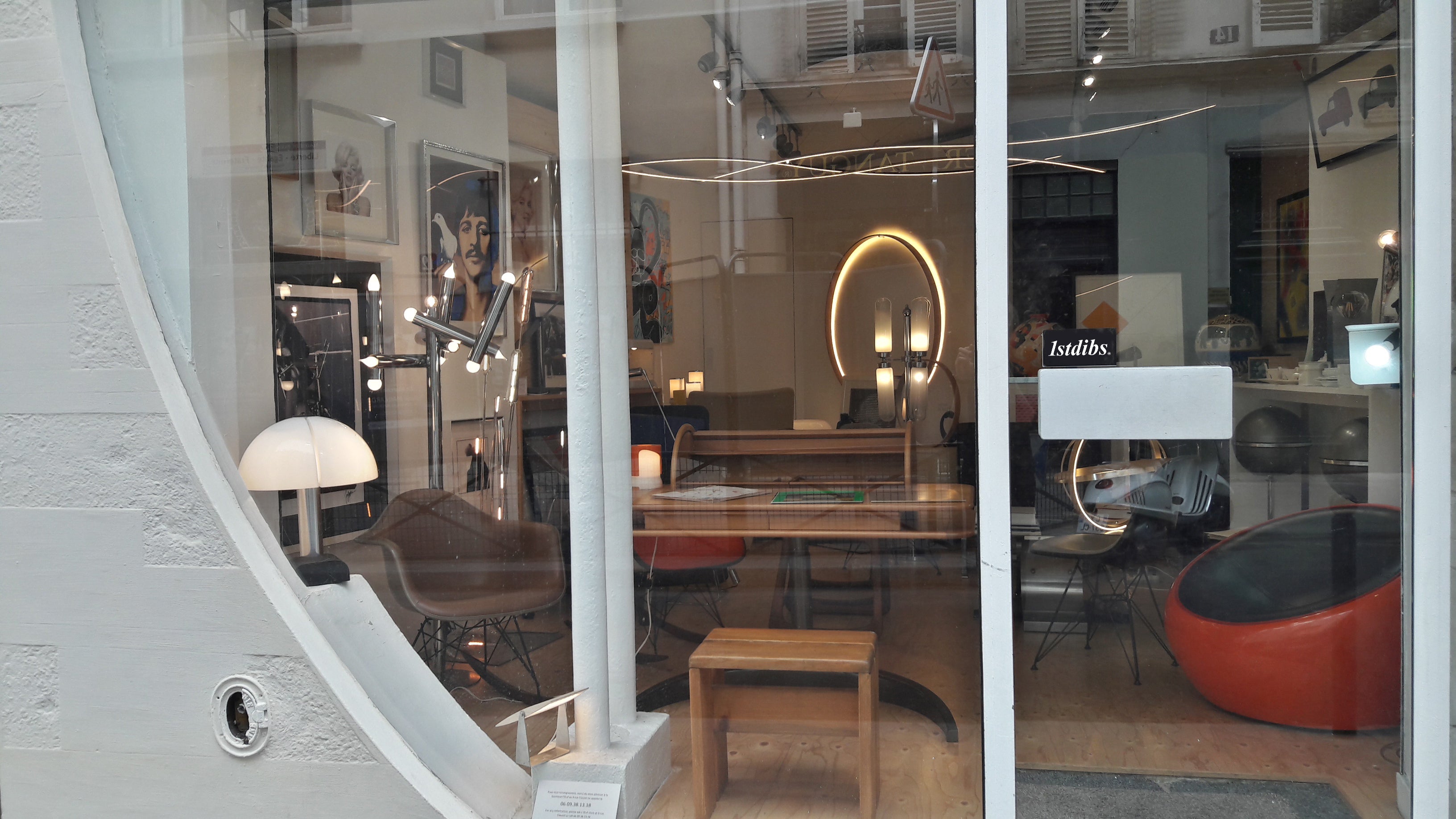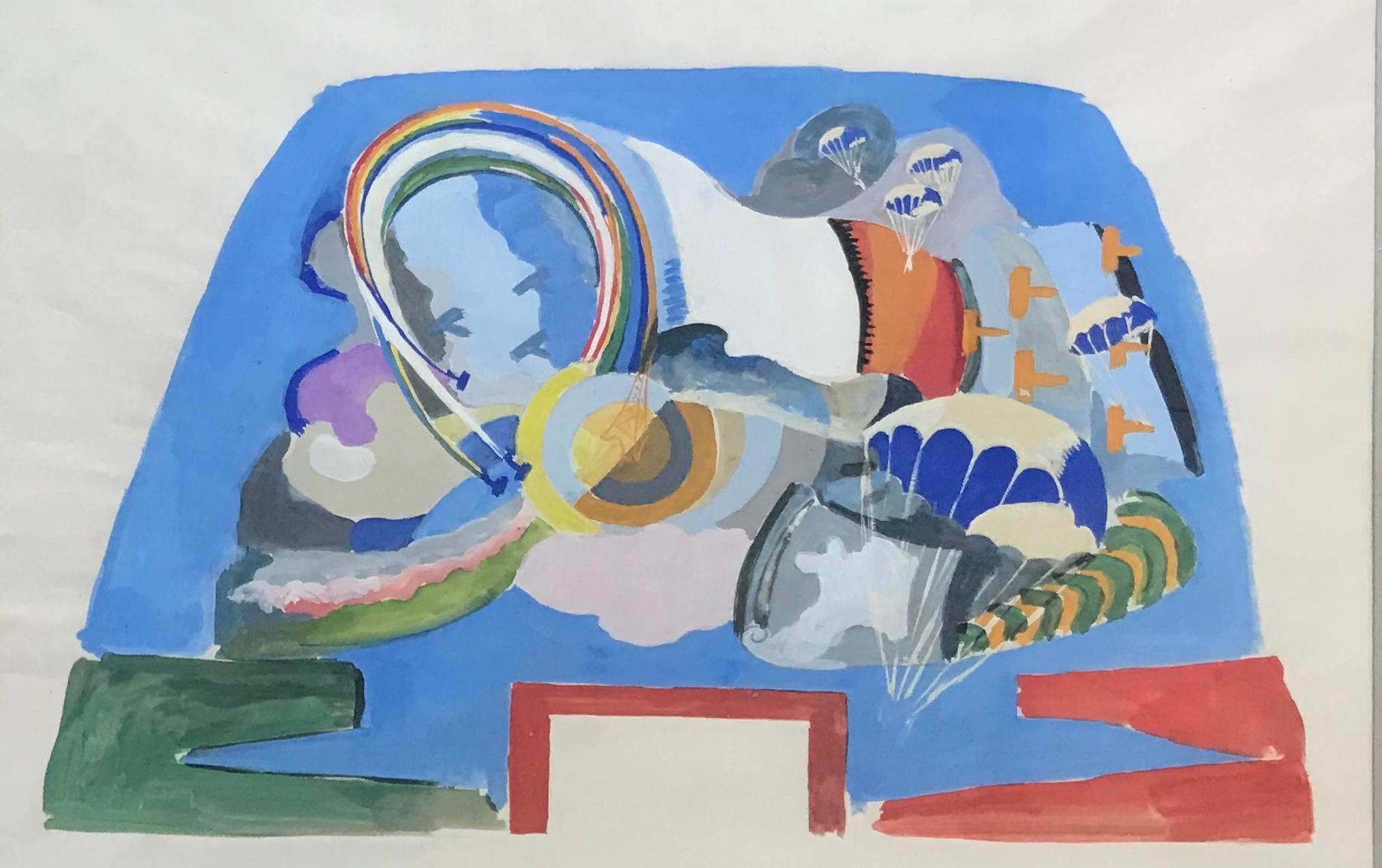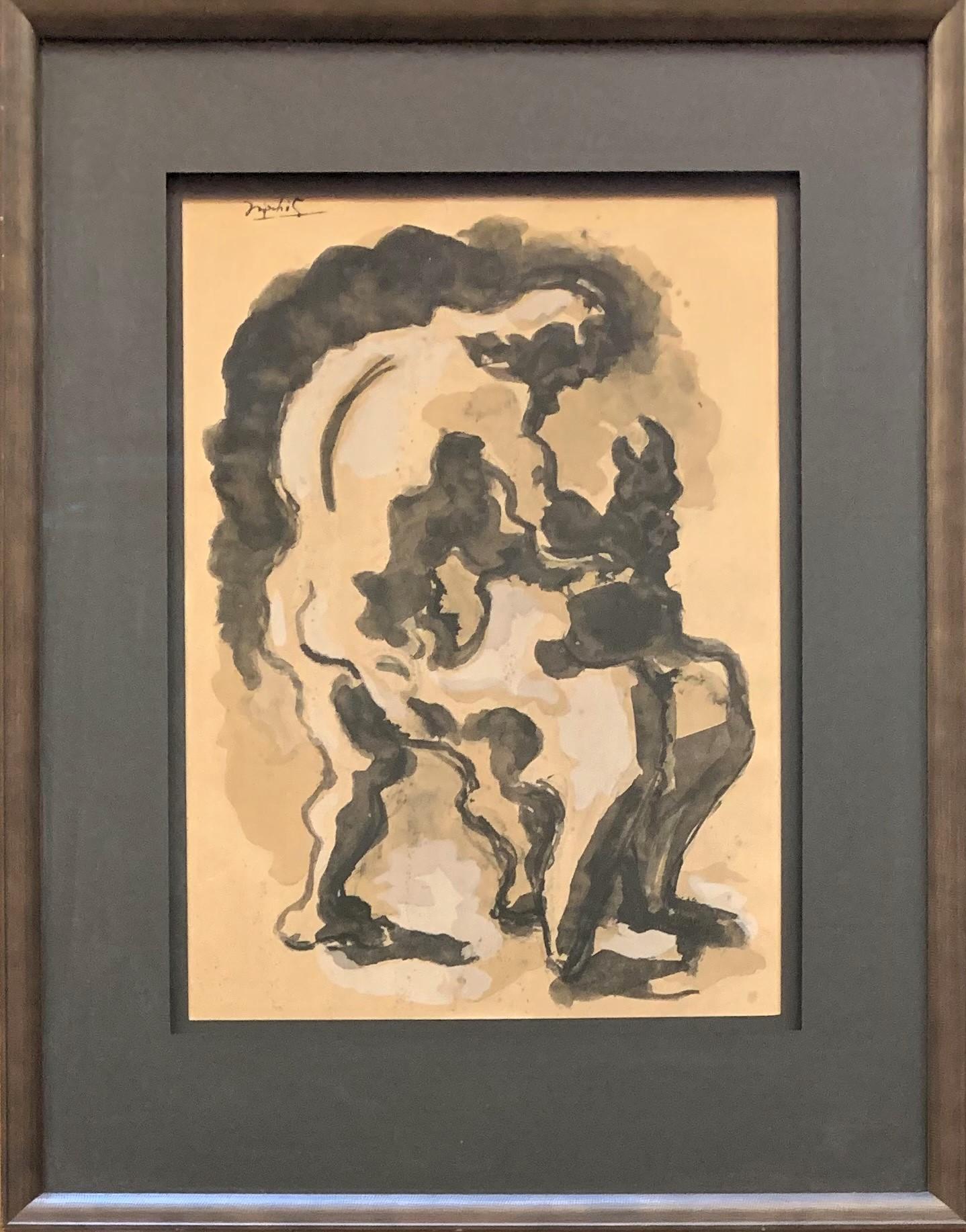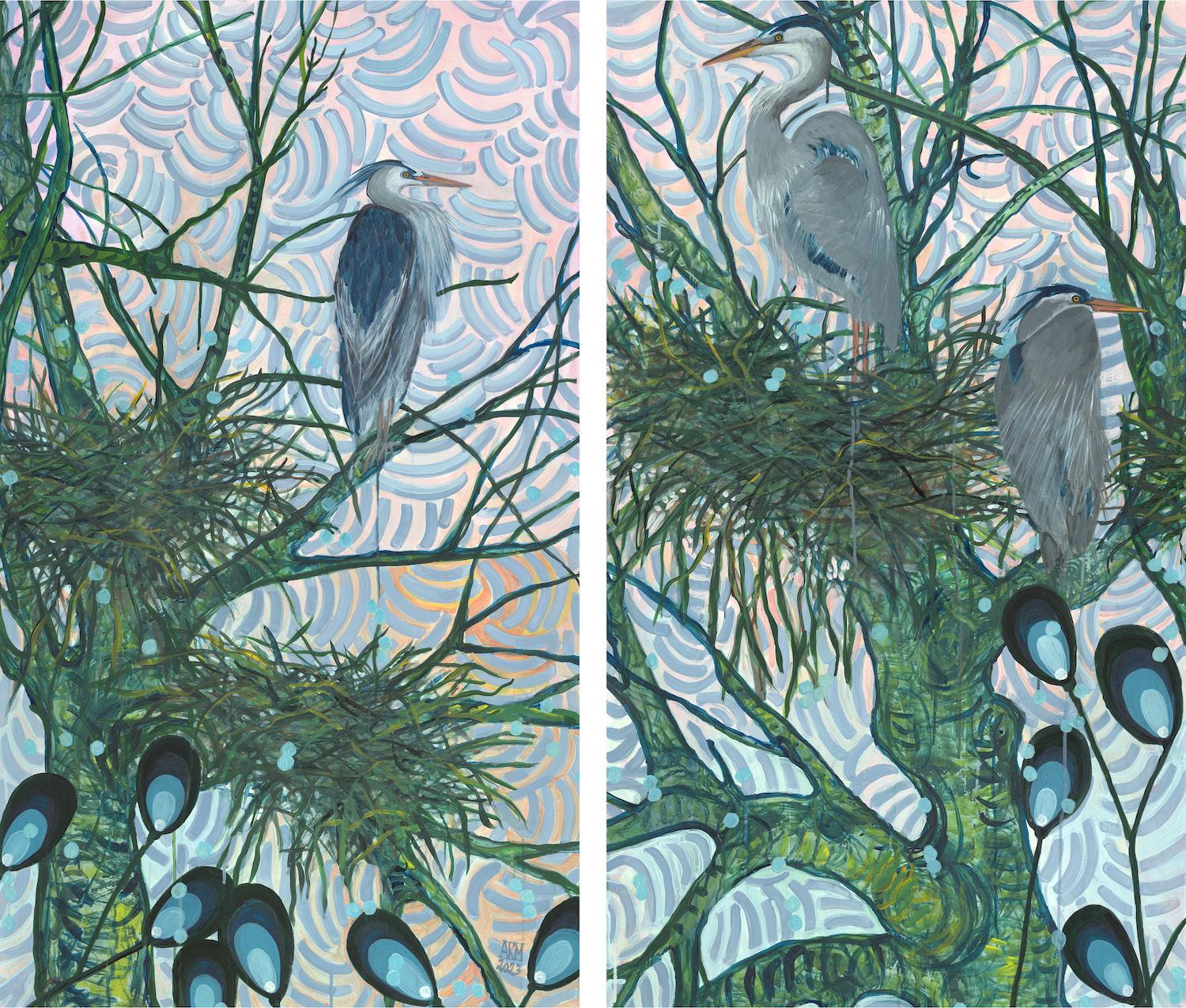Items Similar to Blue Velvet
Want more images or videos?
Request additional images or videos from the seller
1 of 8
Jacques HalbertBlue Velvet
About the Item
Jacques Halbert, born in 1955 in Bourgueil, is a contemporary French artist.
He attended the Brassart school then the École des Beaux-Arts in Bourges. In the 80s, he moved to the United States. He buys the Art Café in New York where he organizes several exhibitions, including Jeff Koons and Andy Warhol, before opening the Magnifik Gallery in the late 90s. Jacques Halbert lives in France since the 2000s.
His art is characterized by two guidelines: performance and painting. His plastic work is reduced almost exclusively to applying one or more cherries on a monochrome canvas. Jacques Halbert himself defines this neo-Dadaist and often parodic stance of the artist's figure as "a manifesto of good taste".
- Creator:Jacques Halbert (1955)
- Dimensions:Height: 14.18 in (36 cm)Width: 10.24 in (26 cm)Depth: 0.4 in (1 cm)
- Medium:
- Period:
- Condition:
- Gallery Location:Saint Ouen, FR
- Reference Number:1stDibs: LU64634062191

About the Seller
4.9
Vetted Seller
These experienced sellers undergo a comprehensive evaluation by our team of in-house experts.
Established in 2015
1stDibs seller since 2017
383 sales on 1stDibs
Typical response time: 19 hours
- ShippingRetrieving quote...Ships From: Saint Ouen, France
- Return PolicyA return for this item may be initiated within 14 days of delivery.
More From This SellerView All
- Langue jongleuseBy Jacques HalbertLocated in Saint Ouen, FRJacques Halbert, born in 1955 in Bourgueil, is a contemporary French artist. He attended the Brassart school then the École des Beaux-Arts in Bourges. In the 80s, he moved to the Un...Category
2010s Figurative Paintings
MaterialsWatercolor
- LOVEBy Jacques HalbertLocated in Saint Ouen, FRJacques Halbert, born in 1955 in Bourgueil, is a contemporary French artist. He attended the Brassart school then the École des Beaux-Arts in Bourges. In the 80s, he moved to the Un...Category
Early 2000s Figurative Paintings
MaterialsWatercolor
- Pierre Jacob - Peanut and loveLocated in Saint Ouen, FRPierre Jacob - Peanut and love Technical Description: Acrylic paint on wood support, thickness = 6mm Dimensions : 60 x 40 cm This image is an evocation of the erotic world of Dali. Giant peanut, furious horse, and a couple in love. These motifs are borrowed from the master. The title recalls: "Peace and Love". References used for this painting: Peacock: motif already present in the painting "Dali Pop Portrait" Horse, after: Salvador DALI "The Temptation of Saint Anthony...Category
2010s Figurative Paintings
MaterialsAcrylic
- « Warhol Pop Portrait »Located in Saint Ouen, FRtitle: "Warhol Pop Portrait Technique: Acrylic paint on canvas Dimensions : 100 x 100 cm Year of creation : 2020 Signature at the bottom of the canvas, on the left description : Fantastic comic characters are installed in front of a large screen, which they look at. On the screen is projected a satirical image of WARHOL. A large open mouth, insects and doodles flutter around without disturbing the calm of the disturbing warriors. In the middle of the scene: a well-known character wonders what he is doing there; he embodies the banality so dear to Andy WARHOL. References used for this painting : The ghost of WARHOL : after Ron ENGLISH Warriors : after Whilce PORTACIO Homer SIMPSON...Category
2010s Pop Art Figurative Paintings
MaterialsAcrylic
- Lemmy Gonthier - Body 2By Lemmy GonthierLocated in Saint Ouen, FRLemmy Gonthier - Body 2 Acrylic Numbered and signed lower right of the work Dimensions: 77 x 68 The human body is at the center of Lemmy's work. His taste for large formats requires...Category
2010s Modern Figurative Paintings
MaterialsCanvas, Acrylic
- Pierre Jacob - Clockwork peanutLocated in Saint Ouen, FRPierre Jacob - Clockwork peanut Technical Description: Acrylic paint on wood support, thickness = 6mm Dimensions : 40 x 30 cm 2020 Description : Malcol...Category
2010s Figurative Paintings
MaterialsAcrylic
You May Also Like
- Study fot he tronconic hall of the Air Palace, 1937. Gouache on paper.Located in Paris, FRStudy fot he tronconic hall of the Air Palace, 1937. Gouache on paper. This is a study most this artist's most important artistic work. Son of the painter Albert Aublet, Felix enrol...Category
1930s Cubist Figurative Paintings
MaterialsGouache
- Prometheus Conquering the Vulture, Gouache Painting, Modern & Cubist 1938By Jacques LipchitzLocated in Saint Augustine, FLArtist: Jacques Lipchitz (1891-1973, French) Title: Prometheus & the Vulture Medium: Gouache & Pencil on Paper Movement: Modern, Cubist Year of Work: Circa 1938 Signature: Top Left ...Category
1930s Modern Figurative Paintings
MaterialsPaper, Gouache, Pencil
- Jacques Lipchitz - Prometheus, Original Gouache PaintingBy Jacques LipchitzLocated in Saint Augustine, FLLipchitz’s reputation for being a painterly Cubist sculptor is understood through his semi-abstract paintings like “Prometheus”. His use of monochrome gouache to create distorted figures from the negative spaces is distinctive. Jacques Lipchitz was a celebrated Lithuanian-born French sculptor best known for his Cubist works...Category
1920s Cubist Figurative Paintings
MaterialsGouache
- Untitled: Abstract Figure and LeavesBy Gio ColucciLocated in Berlin, MDGio Colucci (Italian 1892-1974) Untitled: Abstract Figure and Leaves. Gouache on paper laid down on matt board. Archival framing under glass. Originally from the Con-Agra Corporat...Category
Early 20th Century Abstract Figurative Paintings
MaterialsGouache, Laid Paper
- The Abduction of the Sabine Women , a Renaissance drawing by Biagio PupiniLocated in PARIS, FRThis vigorous drawing has long been attributed to Polidoro da Caravaggio: The Abduction of the Sabine Women is one of the scenes that Polidoro depicted between 1525 and 1527 on the façade of the Milesi Palazzo in Rome. However, the proximity to another drawing inspired by this same façade, kept at the Ecole des Beaux-Arts, and to other drawings inspired by Polidoro kept at the Musée du Louvre, leads us to propose an attribution to Biagio Pupini, a Bolognese artist whose life remains barely known, despite the abundant number of drawings attributed to him. 1. Biagio Pupini, a Bolognese artist in the light of the Roman Renaissance The early life of Biagio Pupini, an important figure of the first half of the Cinquecento in Bologna - Vasari mentions him several times - is still poorly known. Neither his date of birth (probably around 1490-1495) nor his training are known. He is said to have been a pupil of Francesco Francia (1450 - 1517) and his name appears for the first time in 1511 in a contract with the painter Bagnacavallo (c. 1484 - 1542) for the frescoes of a church in Faenza. He then collaborated with Girolamo da Carpi, at San Michele in Bosco and at the villa of Belriguardo. He must have gone to Rome for the first time with Bagnacavallo between 1511 and 1519. There he discovered the art of Raphael, with whom he might have worked, and that of Polidoro da Caravaggio. This first visit, and those that followed, were the occasion for an intense study of ancient and modern art, as illustrated by his abundant graphic production. Polidoro da Caravaggio had a particular influence on the technique adopted by Pupini. Executed on coloured paper, his drawings generally combine pen, brown ink and wash with abundant highlights of white gouache, as in the drawing presented here. 2. The Abduction of the Sabine Women Our drawing is an adaptation of a fresco painted between 1525 and 1527 by Polidoro da Caravaggio on the façade of the Milesi Palace in Rome. These painted façades were very famous from the moment they were painted and inspired many artists during their stay in Rome. These frescoes are now very deteriorated and difficult to see, as the palace is in a rather narrow street. The episode of the abduction of the Sabine women (which appears in the centre of the photo above) is a historical theme that goes back to the origins of Rome and is recounted both by Titus Livius (Ab Urbe condita I,13), by Ovid (Fasti III, 199-228) and by Plutarch (II, Romulus 14-19). After killing his twin brother Romus, Romulus populates the city of Rome by opening it up to refugees and brigands and finds himself with an excess of men. Because of their reputation, none of the inhabitants of the neighbouring cities want to give them their daughters in marriage. The Romans then decide to invite their Sabine neighbours to a great feast during which they slaughter the Sabines and kidnap their daughters. The engraving made by Giovanni Battista Gallestruzzi (1618 - 1677) around 1656-1658 gives us a good understanding of the Polidoro fresco, allowing us to see how Biagio Pupini reworked the scene to extract this dynamic group. With a remarkable economy of means, Biagio Pupini takes over the left-hand side of the fresco and depicts in a very dense space two main groups, each consisting of a Roman and a Sabine, completed by a group of three soldiers in the background (which seems to differ quite significantly from Polidoro's composition). The balance of the drawing is based on a very strongly structured composition. The drawing is organised around a median vertical axis, which runs along both the elbow of the kidnapped Sabine on the left and the foot of her captor, and the two main diagonals, reinforced by four secondary diagonals. This diamond-shaped structure creates an extremely dynamic space, in which centripetal movements (the legs of the Sabine on the right, the arm of the soldier on the back at the top right) and centrifugal movements (the arm of the kidnapper on the left and the legs of the Sabine he is carrying away, the arm of the Sabine on the right) oppose each other, giving the drawing the appearance of a whirlpool around a central point of support situated slightly to the left of the navel of the kidnapper on the right. 3. Polidoro da Caravaggio, and the decorations of Roman palaces Polidoro da Caravaggio was a paradoxical artist who entered Raphael's (1483 - 1520) workshop at a very young age, when he oversaw the Lodges in the Vatican. Most of his Roman work, which was the peak of his career, has disappeared, as he specialised in facade painting, and yet these paintings, which are eminently visible in urban spaces, have influenced generations of artists who copied them abundantly during their visits to Rome. Polidoro Caldara was born in Caravaggio around 1495-1500 (the birthplace of Michelangelo Merisi, known as Caravaggio, who was born there in 1571), some forty kilometres east of Milan. According to Vasari, he arrived as a mason on the Vatican's construction site and joined Raphael's workshop around 1517 (at the age of eighteen according to Vasari). This integration would have allowed Polidoro to work not only on the frescoes of the Lodges, but also on some of the frescoes of the Chambers, as well as on the flat of Cardinal Bibiena in the Vatican. After Raphael's death in 1520, Polidoro worked first with Perin del Vaga before joining forces with Maturino of Florence (1490 - 1528), whom he had also known in Raphael's workshop. Together they specialised in the painting of palace façades. They were to produce some forty façades decorated with grisaille paintings imitating antique bas-reliefs. The Sack of Rome in 1527, during which his friend Maturino was killed, led Polidoro to flee first to Naples (where he had already stayed in 1523), then to Messina. It was while he was preparing his return to the peninsula that he was murdered by one of his assistants, Tonno Calabrese, in 1543. In his Vite, Vasari celebrated Polidoro as the greatest façade decorator of his time, noting that "there is no flat, palace, garden or villa in Rome that does not contain a work by Polidoro". Polidoro's facade decorations, most of which have disappeared as they were displayed in the open air, constitute the most important lost chapter of Roman art of the Cinquecento. The few surviving drawings of the painter can, however, give an idea of the original appearance of his murals and show that he was an artist of remarkable and highly original genius. 4. The façade of the Milesi Palace Giovanni Antonio Milesi, who commissioned this palace, located not far from the Tiber, north of Piazza Navona, was a native of the Bergamo area, like Polidoro, with whom he maintained close friendly ties. Executed in the last years before the Sack of Rome, around 1526-1527, the decoration of Palazzo Milesi is considered Polidoro's greatest decorative success. An engraving by Ernesto Maccari made at the end of the nineteenth century allows us to understand the general balance of this façade, which was still well preserved at the time. The frescoes were not entirely monochrome, but alternated elements in chiaroscuro simulating marble bas-reliefs and those in ochre simulating bronze and gold vases...Category
16th Century Old Masters Figurative Drawings and Watercolors
MaterialsInk, Gouache, Pen
- Large Nature Diptych Heron Rookery Watercolor & Acrylic on Mylar Greens, BluesBy Alex K. MasonLocated in Versailles, KYLarge Nature Diptych by Alex K. Mason of Heron Rookery, " The Rookery" is watercolor & acrylic on Yupo mylar unframed with greens, grays, blues and ...Category
2010s Abstract Expressionist Animal Paintings
MaterialsAcrylic, Watercolor, Mylar





